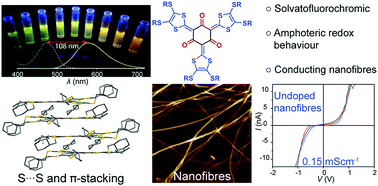Conducting nanofibres of solvatofluorochromic cyclohexanetrione–dithiolylidene-based C3 symmetric molecule†
Abstract
We report a novel set of easily tailorable C3 symmetric molecules with a π-extended core and adorned with different thioalkyl groups, exhibiting solvatofluorochromic and amphoteric redox behaviour. The nearly planar core exhibits intermolecular face-to-face π-stacking, S⋯S and intramolecular S⋯O interactions. Current-sensing atomic force microscopy studies revealed a high conductivity of ∼0.15 mS cm−1 in the undoped J-aggregate nanofibres of the thiopropyl appended gelator.



 Please wait while we load your content...
Please wait while we load your content...